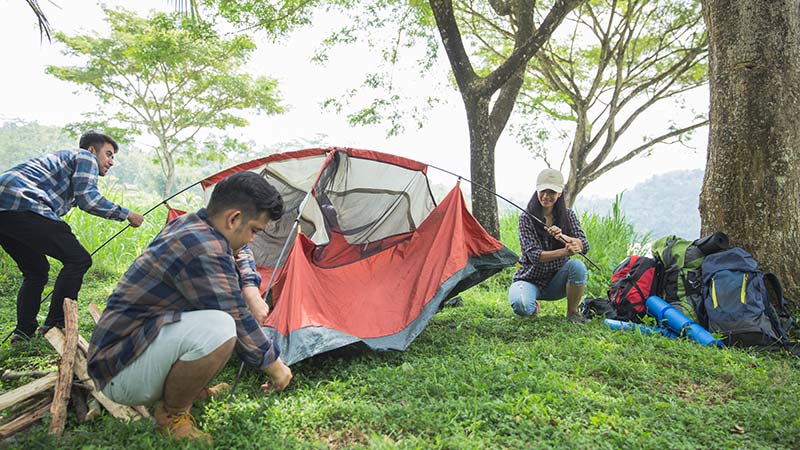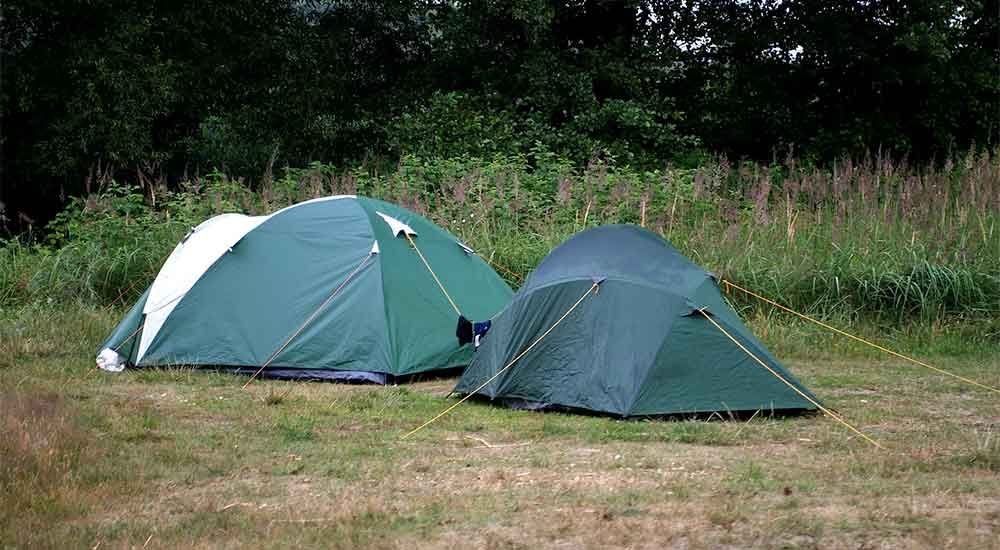Camping and backpacking are outdoor pursuits that are loved by millions of people around the globe. Nothing is better than arriving at your wilderness destination and inhaling that first burst of clean pine-scented air—a smell so pleasant that it is often recreated in car air fresheners.
However, there is one downside associated with the early or initial part of your outdoor adventure: setting up the tent. Just as unpacking ice chests and camping gear can be a laborious chore, so too is the process of setting up one’s tent (s), especially if the tent in question is one with which you are unfamiliar.
To help facilitate the tent setup process, below we have put together a comprehensive guide on how to set up a tent, including some strategies on how to select the perfect spot for your tent, tips on cleaning that spot, and a step-by-step guide for assembling a strong and sturdy tent that can withstand any and all climatic conditions.
Finding the Perfect Spot for Your Tent

Before you even think of setting up your tent, you will first need to find the most ideal spot on which to erect that tent. So what exactly constitutes the perfect spot?
What characteristics should you look for when searching out the most optimal place to set up your tent? These questions and more will be explored in this first section of the article.
If you are camping in a national park, a state park, or in a camping community of sorts that is set up specifically for tent camping, chances are that the perfect spot for your tent will be a no-brainer. That’s because these parks and communities typically have tent pads at each campsite—pads that have been specifically designed for the placement of tents.
But what if you are camping at a standard campsite or out in the wilderness—places at which you are unlikely to see a tent pad? In these cases, you will need to take several things into consideration.
Here are just a few of the things for which to be on the lookout.
- Width. The width of the area at which you intend to place your tent is extremely important. You will definitely need a spot that is wide enough to accommodate the size of your tent—and wide enough to give you a bit of walking room on each side of the tent once it is setup. This will allow you to properly tie down the tent and give you enough room to safely enter and exit it.
- Legal Spot. Perhaps the very first thing you should ascertain when looking for a tent spot is whether or not it is legal to setup a tent there. You definitely want to avoid camping on private property unless you have been given permission by the land owner. Following all of the laws and regulations that govern camping in a particular location will ensure you have a safe and uninterrupted camping experience.
- Flat/Even Spot. You should definitely look for a tent spot in which the ground is flat and even. There is nothing worse than trying to sleep on a slant, as those that have tried it can readily attest to. Try to avoid setting up your tent in places where the ground is uneven, such as where swales, divots and hollows are present. Not only will this allow you to sleep better, it will eliminate the possibility that you might be camping on the lowest ground, where water after a rain tends to pool. Ideally, you should pick a flat and even spot that is a bit higher than the campsite surrounding it. This will help you avoid getting soaked and sleeping in a waterbed that you never planned for.
- Distance from the surrounding campsite. When picking out a spot to place your tent, you want to keep it somewhat away from the remainder of the campsite, but not so far that it requires a long walk to enjoy the other amenities. Try to pick a spot that is upwind of the campsite, and one that is far enough away from the campfire so as not to risk getting hot embers on the tent. If you are wilderness or survival camping and need to place the fire close to the tent for warmth, make sure you are always tending to that fire, and make sure you put the fire completely out before going to bed, preferably using a combination of water and dirt until all the embers have been fully extinguished.
- Rock and Debris-Free. Look for a tent spot that is void of large rocks and pebbles, as well as branches, logs and trees. This will ensure your comfort throughout the night, without having to toss and turn under the pressure of a pebble in your back. One great tip that many campers have learned is this: If you happen to be camping in an area with a lot of pine trees, you might want to gather some pine needles and lay out a thin layer over the spot in which you plan to erect your tent. This will actually provide a little extra comfort as you lounge in your tent.
- Sun Direction. We all know that the sun rises in the east and sets in the west, so you will need to take this into account when setting up your tent. If you prefer to be awoken by the glow of the sun, you will want to place the door side of your tent to the east. Just know that this position can also make your tent get warm very quickly. There are also downsides to setting up your tent to the west. A smarter idea is to place your tent in such a way that the door faces the south. This will give you adequate light in the morning with less heat, and help you to avoid any prevailing winds from the north.
- Wind Direction. When camping in the wilderness, it is very likely that the wind will pick up at some time during the day, especially in the late afternoon and early evening. These winds are usually quite comfortable, but when they become strong they can play havoc on your tent. Thus, you should always try to erect your tent in such a way that the doors to that tent are facing away from the prevailing winds. By doing this, you will not have to worry about the wind turning your tent into a balloon of sorts, placing undue pressure on the stakes and rainfly. In many cases, you can utilize the natural tree line to create a wind break of sorts, which will help keep the winds away from your tent. Tents that are setup close to trees are less likely to feel the pressure of the wind.
Setting Up Your Tent

Now that you have found the ideal spot for your tent, you are ready to begin the process of setting that tent up. The first step in this process is to create a barrier between the ground and your tent.
To do this, you will want to use a vinyl or plastic tarp of some kind. This tarp should be folded carefully so that it matches the relative shape of your tent.
Take care that when setting up the tent that you do not leave any part of the tarp exposed on the outside. If the tarp is exposed, rainwater and moisture will be able to get between the tarp and the bottom of your tent, which can result in a soggy mess to say the least.
Once the tarp has been carefully shaped and laid out, arrange the bottom portion of your tent over the tarp, with the doors and windows positioned correctly, based on the information we provided above in the previous section.
Make sure to lay out the entire tent as neatly as possible, as this will help you with the setup process. At this stage you should also lay out all of the other tent accessories to ensure you will have everything you need.
This means you should lay out the tent, the tent poles, stakes and rainfly (if applicable), and look them over for any possible damage. Once you have accounted for all the parts, you are ready to set up the tent.
Locate your tent poles—usually two for the tent and two shorter poles for the rainfly—and connect them together. Usually the various sections of the poles will have a rope or cord running through them to keep them together, so at this stage you will be connecting all of the various sections together to create two long poles and two shorter poles (rainfly).
Next you are going to insert the poles into the tent. With most tents, you will use the two long poles to create an X-shaped frame—a frame that will support the tent.
Start at one corner of the tent and move the poles diagonally through the provided eyelets or flaps until you reach the opposite corner. Do this step again with the other pole.
Once the poles have been inserted, grab a partner and place the ends of the poles into the provided slot at each corner of the tent. Once they have been fastened, the tent will bend into the perfect shape.
Next you are going to stake the tent down to make sure it doesn’t blow away with a strong wind. Most tents will have looped pieces of cloth at each corner of the tent (and perhaps even a few more loops along the sides).
Place each stake into the loop so that the curved part of the stake grabs onto the cloth, and then pound the stakes into the ground using a hammer or rubber mallet (a rock can also be used for this).
Once the tent has been properly staked at each corner, you can now add the rainfly of your tent if you have one. To do this, simply follow the same steps you used to set up the tent with the poles.
Run each pole diagonally to the opposite corner, and then fasten the ends of the pole to the top of the tent in the provided spots.
Some campers will use a rope or cord of some kind, tied to the tent and a nearby tree to further secure the tent, but that is up to you.
Once the tent has been setup, staked and the rainfly has been added, you are ready to outfit the inside of your tent. This is a matter of personal preference.
Some campers like to use an air mattress in the inside of the tent for comfort, while others prefer just blankets and sleeping bags. Propane heaters inside the tent are great for keeping you warm on those cold mountain nights, and solar lights can be used to play cards or other games before going to sleep.
Always keep a flashlight in one of the tent pockets for those late night bathroom trips, and always remember to take your shoes off outside so as not to drag in any dirt and debris.
